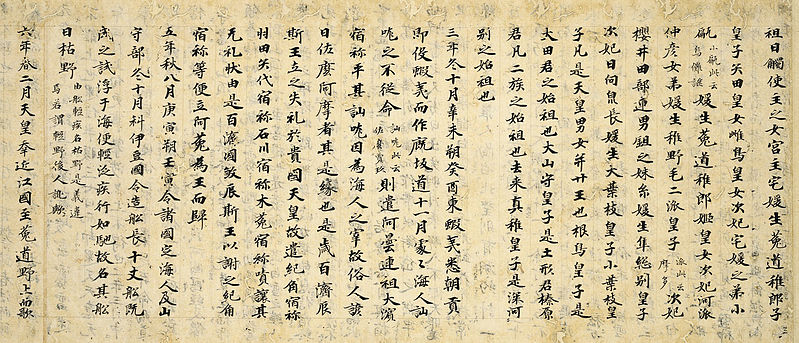The origins of the Japanese language were brought to the islands of Japan by foreign settlers approximately 2,200 years ago. It replaced the language of the native Jōmon inhabitants, hunter-gatherers who are thought to have come to Japan from Siberia around 20,000 BCE.
The earliest example of written Japanese is found in the Kojiki, a book of myths written by a nobleman named Ō no Yasumaro in the year 711 CE at the request of Empress Gemmei. Old Japanese used many more syllables and vowel sounds than what we find in modern Japanese. It used the man’yōgana writing system, which involved the use of kanji (Chinese characters) for both phonetic sounds and pictographic meaning. Several grammatical particles of Old Japanese are still found in many Japanese words today, including tsu, -ru, and ga.
Old Japanese was spoken until the beginning of the Heian period in the year 794. It was succeeded by “Early Middle Japanese” which saw the development of the phonetic hiragana and katakana alphabets – simplified versions of the Chinese characters that had previously been used for phonetics. At the same time there was a reduction of the total number of vowel sounds, and an increase in borrowed words from the Chinese language family. These words were accompanied by Chinese sounds and long vowels/consonants still used in Japanese today. For example, the word “gakkou” – meaning “school” – has lengthened “k” and “o” sounds, as opposed to the incorrect “gako.”
Late Middle Japanese emerged at the beginning of the Kamakura period in 1185, and introduced elements common to modern Japanese. One of these changes was modifying the -te ending (which indicates a present-tense verb) to match the ending sound of the verb, substituting in “-de,” -kute,” “-nde.” and other sounds to produce words such as “nonde” instead of “nomute” from the word “nomu” (“to drink”). Other words had the endings dropped completely, even though some of these endings reappeared in modern Japanese. Literacy in Japan increased during the development of Late Middle Japanese as Buddhism spread throughout the country. In the 16th century Portugese missionaries arrived in Japan, bringing words such as pan (bread) and arukōru (alcohol). The portugese missionaries studied Late Middle Japanese and many details of it were recorded in João Rodrigues’ book “Arte da Lingoa de lapam” (“Art of the Japanese Language”) which was published between 1604-1608.
Japanese in its modern form has existed since the start of the Edo period in the early 17th century. When Edo (the old name for Tokyo) became the capital city of Japan, its dialect became the national standard. Many English words have been adapted into the language over the last 50-60 years, especially those related to technology such as “kamera” (camera) and “terebi” (television). These loanwords are almost always written with the katakana script. Modern Japanese emphasizes different expressions for politeness and uses a subject-object-verb sentence structure. Unlike many other languages there are no word genderizations or plural forms. Before World War II only a handful of non-Japanese Americans could understand the language. Today, Japanese is spoken by over 130 million people, and international interest is growing due in part to the rising popularity of Japanese culture.
